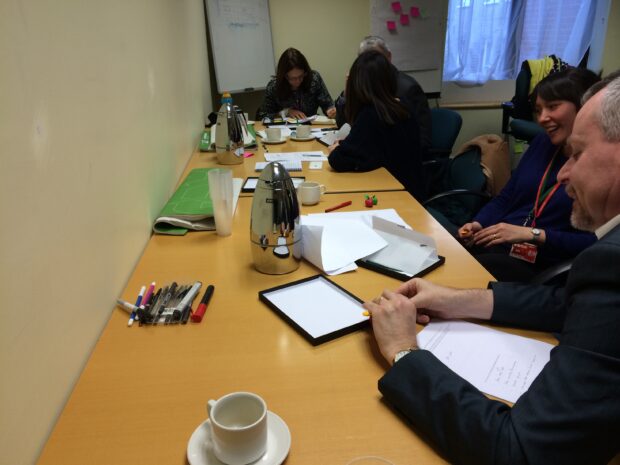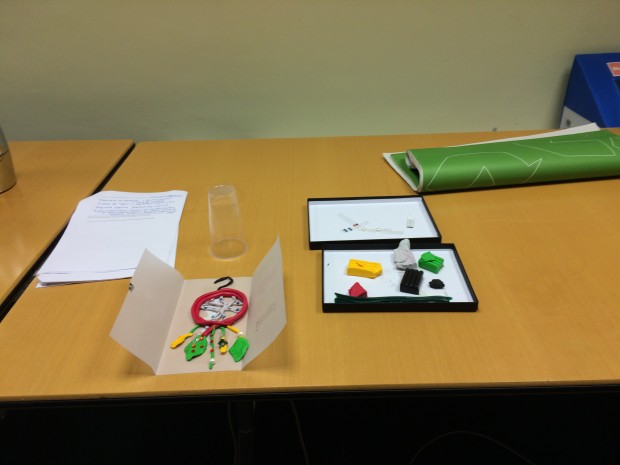One of our top priorities for this year is to build an open policy making toolkit. When our programme started, people wanted to know ‘what is open policy making?’ Now, the question is more often ‘how do I do it?’
The toolkit is going to start answering this question: a website full of tools, resources and guidance on how to use OPM techniques and approaches.
With this project, we’re staying close to our digital and agile roots. We’re following the GDS service design process and the toolkit will be iterative and maintained, added to and improved from when it first goes out for testing throughout its life. We’re currently in the discovery phase – this means we’re thinking hard about policy makers and ‘what is the user need?’ When we know what people need from an open policy toolkit, what information they want, how they want it presented to them, and how they want to navigate to it, only then are we ready to start creating it.
To help us figure out the user need we’re working with Mint Digital. Because they’re from outside, Mint can take a clear look at the problem and come up with a solution that doesn’t have preconceptions about policy environments and what policy professionals need.
Getting people involved
The key part of this work so far has been the user research session we ran last Wednesday. After seeing the interesting things our Lab colleagues do in this area we were very excited to get the post-its and markers out ourselves and dig in to this kind of session. We brought together a number of departments (plus Josephine from Sciencewise who’s been working with Cat, to bring in an insider/outsider perspective - see her blog about the workshop here). We picked the people carefully to ensure a range of attitudes to and experience of open policy making: with 19,000 policy makers in the civil service, we can’t make a toolkit that only works for the early adopters and enthusiasts!
The day covered several exercises. Mint started us off with a conversation about the daily lives of the people in the room, helping them to get a sense of the wide range of activities and responsibilities of policy makers in different departments. We want the toolkit to fit usefully into the working day of policy makers so it was important to look at where the spaces are where that could happen. Then Mint asked about the tools people already use – from the traditional (pencil) to the innovative (crowdsourcing platforms like Dialogue App) – and what they would like to use.
Then we moved on to the fun bit: out came the modelling materials and we asked the policy makers to create the tool that would most make their lives easier. While we noticed one or two raised eyebrows, everyone got stuck in and soon we had an array of works of art representing policy makers’ dearest wishes, from a catcher of fears about taking risks and trying new things, to a glorious gateway for new policies to go through.
Tell me what you want, what you really really want
The afternoon was for a discussion of these ideal tools, exploring the values, ideas and needs that lay behind them. What do policy makers really want and what would help them the most? We found that policy makers are really outcomes-focused: they want tools and methods that let produce the best possible policies for their ministers, policies that deliver ministerial objectives on the ground, with citizens and for citizens’ real lives. They want these tools to be easily accessible so they can understand when and how to use them and how to explain the benefits of them and why they chose them - and why those methods are going to deliver the results their ministers want.
From there we looked at several design concepts Mint have already come up with: ideas for how the toolkit might be structured and navigated. The focus of this discussion was on the toolkit itself and what would help it to be picked up and used by departments and policy makers.
It was a very useful day - and, we hope, interesting for the participants, whose time and energy were much appreciated! Next we’re focusing on completing discovery: Mint will prepare a report on what they’ve found out about the user needs and what we might want to build to fulfill them. tbc...
Subscribe to our email notifications of new posts to keep up with progress of the toolkit and follow us on Twitter.


7 comments
Comment by David Wilcox posted on
Will the toolkit also address the issue of how policy makers may engage collaboratively with outside stakeholders, using their tools? For example, the very promising Grey Cells model being developed by DCLG will require just that, as I wrote here http://socialreporter.com/?p=3202 and I should think cross-boundary working will be increasingly important.
At a fairly mundane, but crucial level, I'm finding civil servants and council officers can't use simple tools like Google docs, Quip and Slack because either they are blocked or IE problems.
Are here any work arounds?
Comment by Lisa Ollerhead posted on
Hi David, thanks for this interesting comment! The outside organisations civil servants work with are an important part of this process - I've just updated this post with a link to a blog written by Josephine about the workshop, she is from Involve and Sciencewise (http://www.sciencewise-erc.org.uk/blog/?p=2716) and there will be content about different ways of collaborating and working with external people. It's important to note though that the toolkit is intended to be iterative and live - the initial launch may not cover everything everyone would like to see but we will be continuing to add tools and ideas based on feedback and what users tell us!
On the tools point - it is a problem. Here in CO we're fortunate to be a while into our tech transition programme and have lovely new kit which lets us do exotic and exciting things like 'watch videos' and 'use Chrome instead of Internet Explorer 7'. A lot of departments are quite restricted and although plans are in motion to change this - see eg https://civilservice.blog.gov.uk/2015/01/22/transforming-the-way-we-work/ - it's a slow process to get over 350,000 civil servants onto great tech and workarounds can be tricky.
Comment by Tim Lloyd posted on
I would suggest that the toolkit will also need to help policy makers work out what they can do quickly, to apply an open approach to their work. In my experience, policy teams, like all civil servants, start out with the best intentions but the timeframes given to deliver work often preclude trying anything new.
A break down of quick wins by hour/half day/day might help put some of this in context.
Comment by Lisa Ollerhead posted on
Hi Tim, we definitely do want it to do that - it was the subject of much discussion and a key point for us from the workshop! During the design phase we'll be considering ways of incorporating the information about the resource needed to use different tools, not just in terms of time but the size of the team and any external costs as well. The policy makers who came along were very clear that they needed to have that information for the toolkit to be useful to them.
Comment by Lydia Ragoonanan posted on
HI there
I've just discovered this site, wondering to myself whether open policy making was a 'thing' at present. Very pleased to know I've stumbled into a live debate. Within my own work we've just done research to understand how and when decision makers within Government want to have information shared with them given the exact constraints (time, money and technical) outlined here. I'd be more than happy to share the output of this (our research was completed in December 2015). In essence I can agree with Tim that people want tool kits and how to guides.
Comment by Paul Cook posted on
Hi Lisa, I'd be interested in hearing more of what you have in mind, and how any toolkit would link to GCS principles (in addition to GDS), behavioural insights techniques, how it helps with evaluations, metrics and post implementation reviews. Also thoughts on when and when not to engage using social media channels. Just some initial thoughts, but here in HSE we have a range of toolkits and advice for policy makers on an intranet (stakeholder mapping tools, guidance review principles to follow etc) and we have our five policy tests in Prezi at https://prezi.com/bs6w4ev8lwgg . How about some kind of App Store for policy makers as opposed to a single toolkit for example? A series of web tools that departments can all use or add to with advice on how to use them.?
Comment by Eric Woodcock posted on
I bought a book called 'How to Run A Government: So That Citizens Benefit and Taxpayers Don't Go Crazy' by Sir Michael Barber recently. I have only scanned it so far but it may be a very helpful addition to your resources if you haven't already got it. It has a lot to say about the practicalities of getting policies that are workable and which are logically implemented.
My own limited experience helping local government was that the Government would pitch a policy into the public sector and expect each authority to puzzle out how they would implement it. There was little emphasis at the authorities on pooling ideas and benchmarking, and the idea of talking to neighbouring authorities to seek best practice or achieve economies of scale was absolutely anathema to most politicians and many administrators I came across. Your work needs to understand and address this.